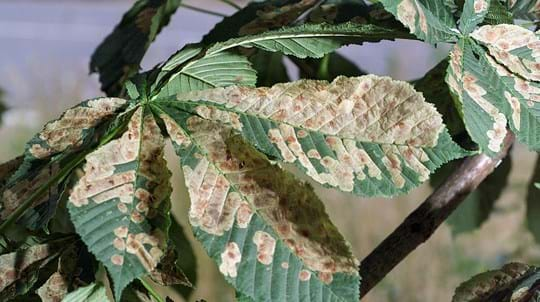
Pests and diseases
Horse Chestnut Leaf Miner
Larvae tunnel into horse chestnut leaves.

Forestry Adviser - National Trust
Have you noticed that, by mid-summer, the leaves of the Horse Chestnut often have brown splotchy marks making the tree look like it’s in autumn colours already?
The Horse Chestnut Leaf Miner is totally defined by its English name:
It lives on Horse Chestnut trees – mainly the widely planted, white flowering variety and only rarely the red flowering variety.
It eats the inside layer between the two outer sides of a leaf and so ‘mines’ the leaf
We’re not sure where the Horse Chestnut Leaf Miner (Cameraria ohridella) originally came from but it was first found in Macedonia in 1985. It arrived in the UK in 2002 and has rapidly spread throughout most of southern and central UK. It continues expanding northwards and westwards each year
A five millimetre long female moth typically lays 20 to 40 single eggs along the lateral veins on the upper side of a leaf. The insect usually hatches in two to three weeks and the larvae passes through five stages inside the leaf before completing its development over four weeks.
The Leaf Miner exclusively feeds inside the leaf leaving both the upper and lower outer surfaces intact. The pupal stage then develops within a silken cocoon inside the ‘mined leaf’. This usually takes about two weeks but in the over-wintering generation, being extremely frost tolerant, it can last for six to seven months.
Out of the cocoon emerges a tiny moth. It has a ten millimetre wingspan. Shiny bright brown forewings are marked with thin silvery white stripes. It flies off to mate and start the lifecycle once again. With such a quick turnaround the Leaf Miner can produce more than one generation during a UK summer – increasing their ability to spread across the country.
From June onwards, a tree suffering from the Leaf Miner has leaves covered with very obvious and sometimes quite large splotches. These start out white but later turn brown. These patches can spread rapidly across the entire tree giving it an autumnal appearance. Eventually the leaves die and drop off but as new leaves grow they are quickly infected.
As trees are mainly attacked late in the growing season (when most of their growth is slowing down) the effect on the tree is greatly reduced compared to what it would have been if the attack had occurred during the height of the growing season. Heavily attacked trees generally do not die but do have reduced growth. This makes them more susceptible to attacks from other diseases and fungi.
There are few natural predators to the Leaf Miner. It hasn’t been in the UK long enough for potential predators to learn to eat the larvae as a food source – especially when hidden inside a leaf. Observations have shown that blue tits, great tits and marsh tits have been seen feeding on larvae but, between them, this would only control between 2 and 4% of the population.
A chemical solution is not recommended due to wider environmental impacts and the fact that the tree is unlikely to die as a result of infestation. It’s also inadvisable to fell infested trees as they still have many valuable attributes and should be retained for as long as it’s safe to do so.
Domestically, it may be possible to collect leaves in autumn and burn them by the end of March (before adult emergence). This will slow down but not eliminate the progress of the Leaf Miner – the moth will fly to new sites if it can’t find what it needs locally.
In a nutshell, we have to learn to live with this insect for the foreseeable future.
We are always interested in tracking the spread of Horse Chestnut Leaf Miner. It is already fairly widespread in England and Wales but if you live in Scotland and spot it, please report it through TreeAlert.
Next time you see a Horse Chestnut leaf with this insect inside, try splitting the leaf horizontally and see if you can prise the larva out of its comfortable home.